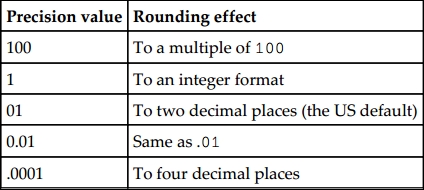Data conversion and formatting functions
Some data type conversions are handled in the normal process flow by NAV without any particular attention on part of the Developer, such as Code to Text and Char to Text. Some data type conversions can only be handled through C/AL functions. Formatting is included because it can also include a data type conversion. Rounding does not do a data type conversion, but it does result in a change in format (the number of decimal places). Let's review the following functions:
- The
ROUNDfunction - The
FORMATfunction - The
EVALUATEfunction
ROUND function
The ROUND function allows us to control the rounding precision for a decimal expression. The syntax for the ROUND function is as follows:
DecimalResult := ROUND (Number [, Precision] [, Direction] )
Here, Number is rounded, Precision spells out the number of digits of decimal precision, and Direction indicates whether to round up, round down, or round to the nearest number. Some examples of Precision values follow:

If...




































































